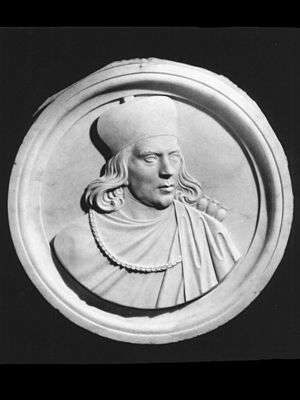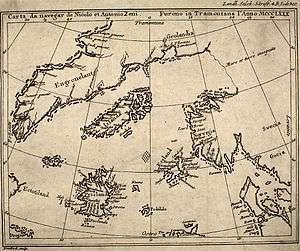Zeno brothers
The Zeno brothers, namely Nicolò (c. 1326–c. 1402) and Antonio Zeno (died c. 1403) were Italian noblemen from Venice living in the second half of the 14th century, who were famous during the Renaissance for a possible but controversial exploration of the north Atlantic and Arctic waters. They were brothers of the Venetian naval hero Carlo Zeno. The Zeno family was an established part of the aristocracy of Venice and held the franchise for transportation between Venice and the Holy Land during the Crusades.

Letters and the Zeno Map
Nicolò and Antonio are notable for a number of letters and map (called the Zeno map) published in the year 1558 by one of their descendants, also named Nicolò Zeno. This descendant was a historian with other published works on the history of Venice.[1]:10 The letters, allegedly written by the brothers around 1400, describe a voyage of exploration that they say they undertook throughout the North Atlantic (and by some interpretations to North America), under the command of a prince named Zichmni (whom some have identified as Henry Sinclair). Some commentators have suggested that a descendant, William Sinclair (c.1404-c.1484), (builder of Rosslyn Chapel) had knowledge of Henry Sinclair's involvement with the Zeno brothers and had decorated the interior of the chapel with carvings of plants discovered during the voyage. This claim of 'proof' that the voyage took place has been discredited.[2]
The letters and accompanying map are controversial and are regarded by at least one historian as a hoax, either by the Zeno brothers themselves or by their descendant who wrote a narrative which he said was based on what was left of letters that he had torn up as a boy.[3] In 1989, Italian scholar Giorgio Padoan a published study[4] suggesting that there is some authenticity in their travels and that Nicolò is not to be found in any document between the years 1396–1400 (so he could have been at least in Iceland),[5] while Andrea Di Robilant has written a book on this possibility.[1]
The letters

The letters are divided into two parts. The first set contains letters from Nicolò to Antonio. The second consists of letters from Antonio to their brother Carlo.
The first letters (from Nicolò to Antonio) tell how Nicolò set off in 1380 on a voyage from Venice to England and Flanders. Evidence exists that such a voyage took place, and that Nicolò returned to Venice around 1385.
In the letters, Nicolò describes being stranded on an island between Great Britain and Iceland called Frislanda, which is described as being larger in size than Ireland.
By chance Nicolò is rescued by Zichmni, who is described as a prince who owned some islands called Porlanda off the southern coast of Frislanda, and who ruled the duchy of Sorant, or Sorand, south-east of Frislanda. It has been suggested that Frislanda is in fact a stand-in for the Faroe Islands with individual islands mistakenly merged into a single landmass by Nicolò the younger, although Frisland and the Faroe Islands both appear on several maps, many hundreds of miles apart.
Nicolò invites Antonio to come to Frislanda with him, which he does, and stays for fourteen years. Under Zichmni's direction, Antonio attacks "Estlanda", which is ostensibly the Shetland Islands, as indicated by the similarity of place names mentioned in the letters.
Zichmni then attempts to attack Iceland. After finding it too well defended, he attacks seven islands along its eastern side: Bres, Talas, Broas, Iscant, Trans, Mimant, and Damberc. All of these islands are fictitious. An alternative interpretation finds that in transcribing the letters the Zeno brothers' descendant mistook a reference to "Estlanda" for "Islanda" or Iceland, thus accounting for both the presence of those superfluous islands off Iceland and the mysterious absence of an equal number of islands off of the Shetland Islands. Further evidence in support of this claim is the similarity of place names in the Zenos' "Islanda" to modern day Shetland, for instance the island of Bressay for "Bres" and Danaberg sound near Lerwick for "Damberc".
Zichmni then builds a fort on Bres and leaves Nicolò in charge of it. Nicolò makes a voyage to Greenland and finds a monastery with central heating. According to the alternative interpretation cited above, in which the travellers had yet to leave Estlanda, the subsequent destination is in fact Iceland, explaining the presence of geothermal heating and other observations.
Zichmni receives word that a group of lost fishermen from Frislanda have returned after an absence of over twenty-five years. The fishermen describe making landfall in the far west in unknown countries called Estotiland and Drogeo. They claim to have encountered strange animals as well as cannibals, from whom they escaped only after teaching the cannibals how to fish.
Inspired by the tales of the fishermen, Zichmni undertakes a voyage to the west with Antonio in charge of his fleet. To the west of Frislanda (see Zeno Map), they encounter a large island called Icaria, which does not exist.
According to the letters, the inhabitants of Icaria greet them before they can make landfall. Only one person among the Icarians is able to speak a language that Zichmni understands. The inhabitants state that visitors to the island are not welcome and that they will defend the island to the last man if need be. Zichmni sails along the island looking for a place to make landfall, but the inhabitants chase him and Zichmni abandons the effort.
Sailing west, they make landfall at a promontory called Trin on the southern tip of "Engrouelanda". Zichmni likes the climate and the soil, but his crew find it inhospitable. The sailors return home with Antonio, while Zichmni stays on to explore the area and build a town.
Controversy and criticism
The account of the voyages given by the younger Nicolò continues to attract debate. Some of the islands they allegedly visited either conflate existing locations or do not exist at all.[6][7] Research has shown the Zeno brothers were occupied elsewhere when they supposedly were doing their exploring.[8] Contemporary Venetian court documents place Nicolò as undergoing trial for embezzlement in 1394 for his actions as military governor of Modone and Corone in Greece from 1390–1392. He wrote his last will and testament in Venice in 1400, many years after his alleged death in Frislanda around 1394. There is disagreement about the brothers' whereabouts at the time of the supposed voyages, with some readings of archival records placing the brothers in Venice at that time. Andrea di Robilant suggests this interpretation is in error.
According to The Dictionary of Canadian Biography Online, "the Zeno affair remains one of the most preposterous and at the same time one of the most successful fabrications in the history of exploration."[8] Herbert Wrigley Wilson described and analysed the story at length in The Royal Navy, a History from the Earliest Times to the Present, and was sceptical about its veracity, noting " At the date when the work was published Venice was extremely eager to claim for herself some share in the credit of Columbus's discoveries as against her old rival Genoa, from whom Columbus had sprung."[9] Di Robilant disagrees, stating that the younger Nicolò was "a first-class muddler, not a fablemonger", whose inaccuracy was the result of second-hand retelling that still contains much of the truth of his forebears' voyages.dir
Footnotes
- Di Robilant, Andrea (2011). Irresistible North: From Venice to Greenland on the Trail of the Zen Brothers. Knopf. ISBN 978-0-307-26985-0.
- Cooper, Robert L. D. (2006). The Rosslyn Hoax. pp. 188–189. ISBN 978-0-85318-281-8..
- Major, Richard H. (1873). The Voyages of the Venetian Brothers Nicolo & Antonion Zeno to the Northern Seas in the XIVth Century. pp. v–vi.
- Padoan studied the "detailed descriptions that could have not been borrowed by others" -as geographer Von Humboldt stated- in the book written by younger Nicolo' about his father
- Padoan, Giorgio (1989). "Sulla relazione cinquecentesca dei viaggi nord-atlantici di Nicolò e Antonio Zen (1383-1403)". Quaderni Veneti (9): 7-104.
- Lainema, Matti; Juha Nurminen (2009). A History of Arctic Exploration: Discovery, Adventure and Endurance at the Top of the World. Conway. p. 101. ISBN 978-1-84486-069-2.
- Mills, William James (2003). Exploring Polar Frontiers: A Historical Encyclopedia. ABC-CLIO. p. 247. ISBN 9781576074220.
- Oleson, T. J. "Zeno, Nicolo and Antonio". Dictionary of Canadian Biography Online.
- Wilson, Herbert Wrigley (1897). "Voyages and Discoveries 1154–1399". The Royal Navy, a History from the Earliest Times to the Present. By Clowes, William Laird. London: Sampson Low, Marston and Company. pp. 324–337.
Sources
- Cooper, Robert L. D. (Ed.) The Voyages of the Venetian Brothers Nicolo & Antonion Zeno to the Northern Seas in the XIVth Century. Masonic Publishing Co. 2004. ISBN 0-9544268-2-7.
- Di Robilant Andrea. Irresistible North: From Venice to Greenland on the Trail of the Zen Brothers. Publisher Alfred A. Knopf. New York, 2011 ISBN 030726985X
- Smith, Brian. Earl Henry Sinclair's fictitious trip to America. New Orkney Antiquarian Journal, vol 2., 2002
- Horodowich, Elizabeth (Fall 2014). "Venetians in America: Nicolò Zen and the Virtual Exploration of the New World". Renaissance Quarterly. 67 (3): 841–877. doi:10.1086/678776.
External links
- The Voyages of the Venetian Brothers, Nicolò and Antonio Zeno, to the Northern Seas in the XIVth Century, comprising the latest known Accounts of the Lost Colony of Greenland; and of the Northmen in America before Columbus. Translated and Edited, with Notes and an Introduction, by Richard Henry Major, Hakluyt Society, 1st ser., London 1873. Pages ciii, 64 + 4 maps.
- Earl Henry Sinclair's fictitious trip to America by Brian Smith, First published in New Orkney Antiquarian Journal, vol. 2, 2002
- "Early Italian Images of America" by Scaglione, Aldo